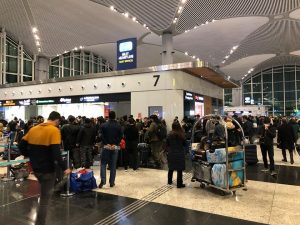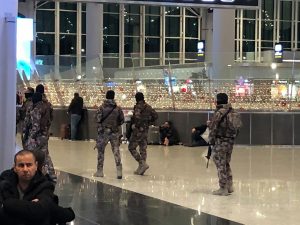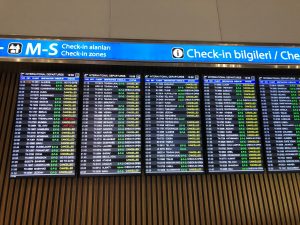By Mendee J and Julian Dierkes
We recently collated information about dates and procedures for the upcoming parliamentary election in June. Julian discussed some of the implications of multi-member majoritarian voting with his colleague Max Cameron in a podcast. Now, let’s turn to an outlook on political parties likely competing.
36 Registered Parties
As of late March, there are 36 parties registered at the Supreme Court of Mongolia. The new law on parliamentary elections requires any of these parties, wishing to participate in the upcoming parliamentary elections, to submit their election platforms to the National Audit Office before March 25 for the economic/financial feasibility review. So, most assume the election would go ahead as scheduled on June 24 – but, of course, the current coronavirus outbreak could necessitate delay or postponement. However, parties have few options – except to organize their meetings (congress, plenums, workshops) virtually. This would be a new dimension for all parties – success will depend on IT expertise, infrastructure, and even personal skills – how to use them effectively, efficiently, and, of course, securely.
Usual Suspects – MPP, DP, and MPRP
The Mongolian People’s Party (MPP) is the current ruling party, which is in control of 65 out 76 seats of the parliament and running the cabinet (i.e., all ministries and agencies, state-owned enterprises). Since the MPP won in the local elections (i.e., capital city/districts, provinces/soums), the party leadership surely have influence over local party committees and their candidates will be favoured by local authorities. In the aftermath of the 2016 election, the MPP has experienced a power struggle between two major factions: one led by the incumbent Prime Minister Khurelsukh U and the other by former speaker Enkhbold M. In the end, the Khurelsukh faction got the upper hand by dominating the party secretariat and key organizational hierarchy as well as leadership posts at the legislature, cabinet, and local governments. Literally, Prime Minister Khurelsukh, as a party chairman, now controls the candidate list; therefore, Enkhbold’s supporters will probably follow his lead. Currently, the MPP has 63 MPs (12 female, 51 male) – two members were removed because of criminal investigations and one more could be sentenced in coming months in connection to the Small Medium Business Fund misappropriation/corruption. The MPP will conduct its online meeting (Governing Board) on March 22-23. Note: the MPP claims 161,000 members.
The Democratic Party (DP) is a coalition of several opposition parties. After being a majority party in the 2012-2016 parliament, the party lost disastrously in the 2016 election mostly due to the party’s mismanagement of the government and divided/competing leadership. The DP was reduced to 9 seats (1 female, 8 male) in the 2016 parliamentary election. Interestingly, the party’s candidates won in the presidential elections since 2009: Elbegdorj Ts in 2009, 2013 and Battulga Kh in 2017. Because of deficient separation of power, the presidential post provides some power/influence over judiciary, foreign policy, and security apparatus and gives the power to securitize any matters presumed as national security importance thorough the National Security Council, the highest consultative body, which is chaired by the president. At the moment, the DP has lost two popular MPs (i.e., Batzandan and Bold) and appears to be in the middle of a fratricidal power struggle. Unless magic happens, the party has very little time to get organized and put forward a winning strategy. The DP organized its first online conference (National Policy Committee) on March 14. Note: the DP claims 150,000 members.
The Mongolian People’s Revolutionary Party (MPRP) is the third party with one seat in parliament. The party was established on January 28, 2011, when the MPP changed its name to disconnect from its communist legacy. But the name change provided unique opportunity for former president, prime minister, and speaker Enkhbayar N to establish a breakaway party for members and supporters who liked the old name. The MPRP merged with former Prime Minister Enkhsaikhan’s party which won a substantial number of seats in the 2012 parliamentary elections and played a game changer role between the MPP and DP competition in legislature and cabinet. In comparison to other smaller parties, the MPRP has some networks, which might challenge the MPP’s candidates in the countryside. Earlier this month, the MPRP decided to establish a coalition with Civil Will Green Party (CWGP) and Green Party (GP). The CWGP has been regarded another successful, small party, which used to be led by Oyun S, a well-known politician, who is no longer connected to the party. Note: the MPRP claims 35,000 members, CWGP 35,000, and Green Party 2,100.
Emerging Actors – The Right Person & The Electorate
The National Labour Party – or known as HUN party was established in November 2011, but failed to secure seats in the last parliamentary elections. Some obvious factors contributing to this failure were: (1) leadership struggles, (2) limited resources (esp., funds), and (3) lack of popularity and organizational capacity. The party seems like it may have learned its lessons and has worked hard to publicize policy platforms and potential candidates since 2017. On March 20, the HUN party declared the establishment of a coalition with the Mongolian Social Democratic Party (MSDP) and newly established Justice Party (Зүй ёс) for the upcoming election.
The MSDP was one of earlier opposition parties in the 1990s, joined the DP in 2000, and then became a breakaway party from the DP. The Justice Party was established in June 2019. Interestingly, the core leaders and supporters (30-40) have been educated in Japan and joined together to promote key values (e.g., justice, rule of law, public interests, discipline, order, trust) by competing in the parliamentary election. The Justice Party is supported by the Association of Mongolian Alumni from Japan. Note: HUN party claims 1,024 members, MSDP 3,000, and Justice Party 2,000.
The Electorate Movement was established on March 28, 2019 to endorse the “right” candidates for the parliamentary election. The movement was initiated by well-known public figures, for example, former Prime Minister Sodnom D, former Finance Minister Byambajav E, former politician Oyun S, composer Jantsannorov N, Hamba Lama Choijamts D, and columnist Baabar (Bat-Erdene, B). The 60 members of Electorate were elected on two criteria: public figures without (1) a bad reputation, and (2) without intentions of seeking political posts. The movement will declare their support for the right candidates before the election and concludes an ethical contract with candidates. The movement will not conduct negative campaigning against other parties and candidates and support only one candidate per electoral district. Last month, the Electorate Movement accepted requests of the coalition of HUN and MSDP and agreed to support their candidates. As having well-known figures like cosmonaut Gurragchaa J, former Foreign Minister Gombosuren, and composer Jantsannorov, the movement could definitely have an impact on voting. Like 2012, the election will open opportunities for third parties especially when voters realize that two major parties are not effective in dealing with corruption.
Independents
The famous singer Javkhlan S has been the only independent member in the current parliament and we expect an increased number of independent candidates, but it is hard to speculate how many will be successful. Leaders of small political parties will probably have some chance to getting elected because of the majoritarian electoral system. Former civil society entrepreneur and DP member MP Batzandan J and long-time politician, former DP, MP Bold Lu established Joint Coalition Party of Just Citizens (Шударга иргэдийн нэгдсэн эвсэл нам) – or the party with a long name on September 2019. The Ger District Development Party (Гэр хороолол хөгжлийн нам) could get a seat through strong support from ger districts. The party was established in January 2019 and is believed to have connection to former mayor Bat-Uul E (DP). It is not hard to expect a successful election by the Republican Party Leader, Jargalsaikhan D, known as Buyan Jagaa. However, if any of them get elected, they would probably act as independent members.
In past elections, we have seen a large number of athletes run for political office. There is no reason to expect that not to be the case in the coming election. Likely candidates may be former Sumo star Dagvadorj, and Judo gold medalist Tuvshinbayar, but others may also emerge in the campaigning. Above all, this may turn out to be the county’s first election which will be forced to use the virtual space from the planning, competing, and, of course, to electronic voting. It is quite timely for the Facebook sets up its mission (Facebook War Room) in Mongolia to make sure the fair competition gets on the Facebook.

 Follow
Follow


